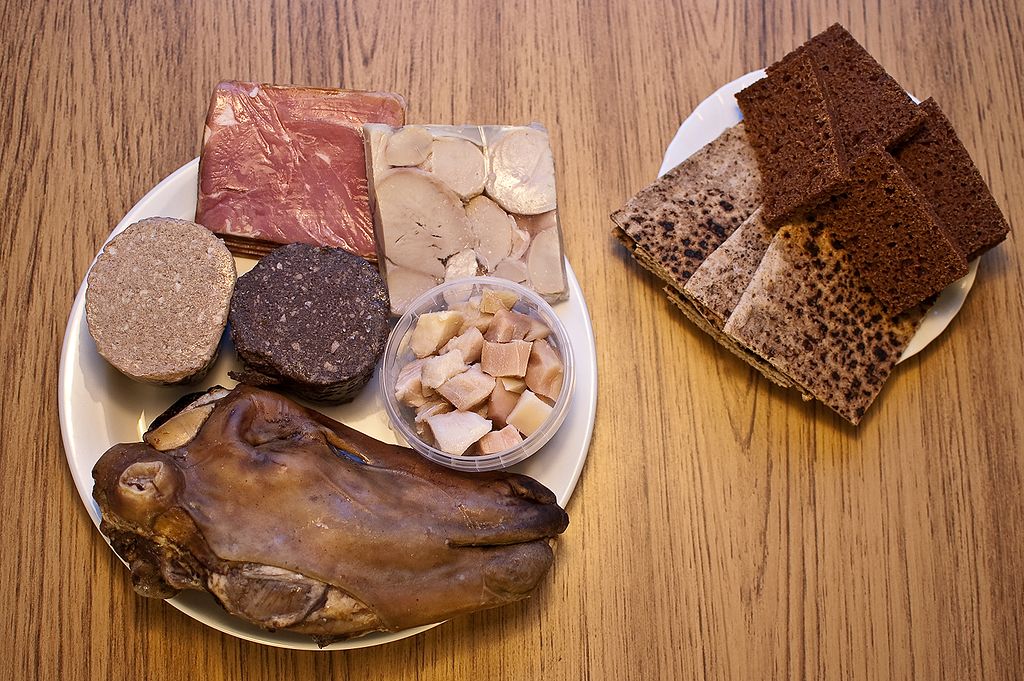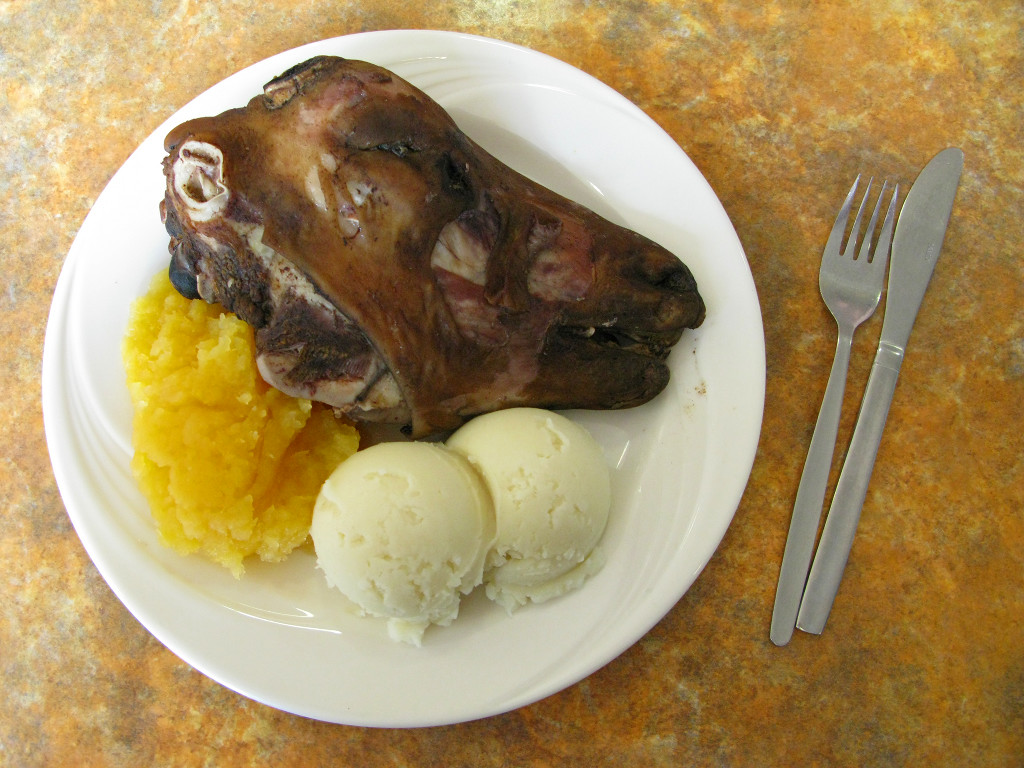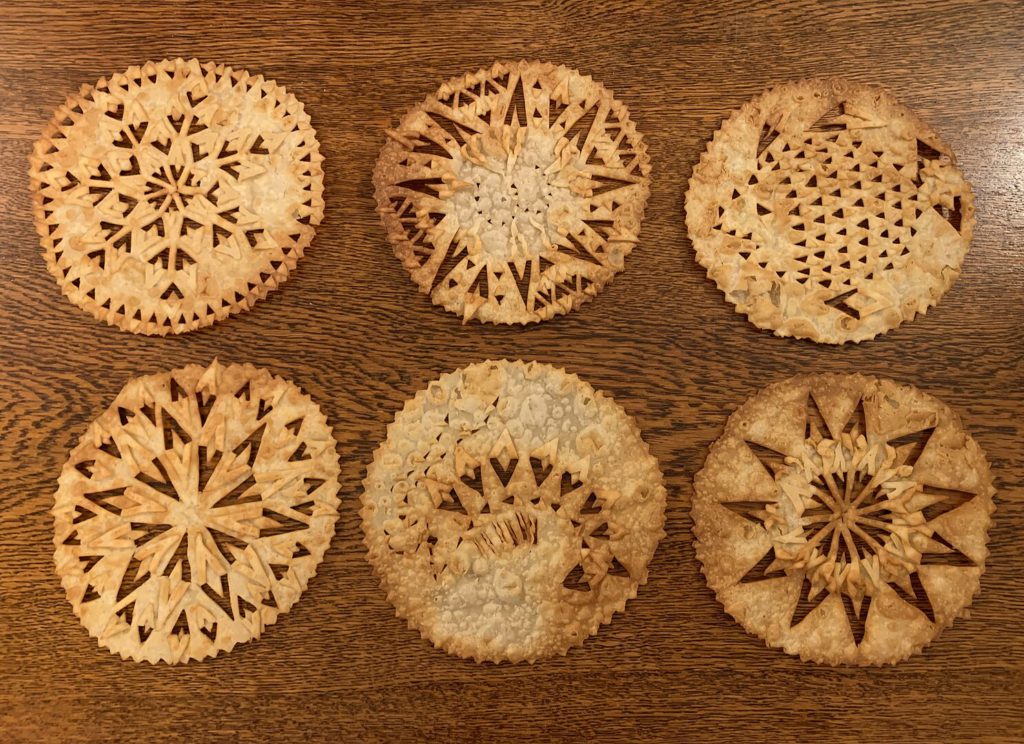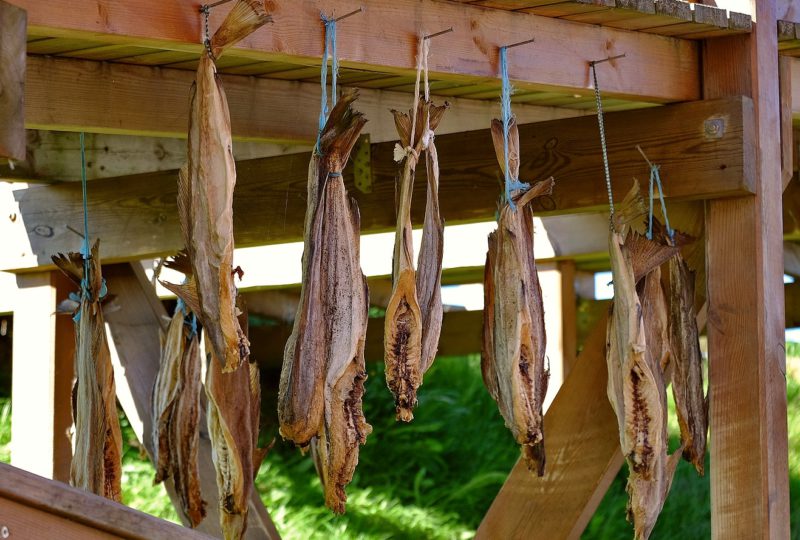When it comes to strange food, almost every culture across the globe has its fair share of unique traditions and cuisine specific to them. Iceland is no exception, with much of its food history stemming from the age of the Vikings when smoked meats and fermented seafood were all the rage. Some of the most intriguing traditional delicacies are eaten during the coldest month of the year during Þorri, between late January to late February. This is when Iceland celebrates Þorrablót, a feast festival that sees the likes of sheep’s head, fermented shark, ram’s testicles, and other intriguing delicacies served with plenty of brennivín (“burning wine”), Iceland’s signature distilled spirit. We’re about to shed some light on eight of these weird foods of Iceland, each guaranteed to make your taste buds at least a little curious.

Hákarl (fermented shark)
Image above by Loïc Brohard Photography (@travel.explore.photos).
Hákarl is what people usually think of first when you ask them to name a strange Icelandic food. A national dish in its own right, hákarl is shark (usually Greenlandic shark or some other type of sleeper shark) that has gone through a unique fermentation process. The reason for the fermentation might surprise you: fresh shark meat is poisonous due to its high levels of urea and trimethylamine oxide. To combat this, the shark is buried in a shallow, gravelly pit of sand under heavy rocks and left to putrefy for several weeks until all fluids are pressed out of the body. Following this, it is dug out, cut into slices, and hung to dry for about seven months.
How does it actually taste? Well, it’s not the most palatable food for beginners, that’s for sure. With its strong, ammonia-rich smell and fishy taste, it might be difficult to hold back a grimace when nibbling on hákarl for the first time. There’s a reason why Icelanders down shots of brennivín when they eat the stuff! But if you’re ever up for it, the fermented shark is readily available in stores in Iceland and can be eaten all year round, including during þorramatur. They’re often served in small cubes and eaten with toothpicks. Here’s a tip: The odor of hakarl is stronger than its taste — hold your nose when you take your first bite and you might find it much more agreeable!
Hrútspungar (ram’s testicles)
Did you do a double take? Yes, ram’s testicles — known as hrútspungar — are an Icelandic delicacy. The testicles are washed thoroughly before the outer membranes are removed. They are then boiled and pickled in whey for several months, with the whey changed regularly throughout the waiting process to avoid bacterial growth. Once the testicles reach the proper level of acidity, they are then pressed together and set in gelatin to form a rectangular block, made to be sliced and eaten as a pâté or starter.
Perhaps unsurprisingly, this is no longer a common food found in Iceland, its origins being a “poor farmer’s food” that stemmed from the need to not waste any part of an animal. However, hrútspungar is one of the foods you’ll find served at Þorrablót, and maybe you’ll want to give it a taste when you’re in Iceland.
Hverabrauð (hot spring bread)
For something a little less daunting, try some Icelandic rye bread (rúgbrauð). More specifically, try the version cooked underground in hot volcanic sands. This is known as hverabrauð, or hot spring bread. Sometimes, you’ll also hear it being called “lava bread” or “volcanic bread”. The idea of using the ground as an oven is an old one, spanning many cultures and generations. In Iceland, with geothermal activity common, it’s only natural that the ground be used as a means to cook with.
The process of making rúgbrauð the volcanic way starts with a dough of dark rye and wheat flour mixed with baking powder, baking soda, buttermilk, golden syrup, and a bit of salt. This dough is sealed in a metal container and buried in the hot ground to bake overnight. The result is a dense, moist, spongy bread with a hint of sweetness and a texture almost like cake. It is best served hot and fresh, with a small slather of butter or topped with smoked herring.
Harðfiskur (dried fish)
One of the more common traditional staples of Iceland, harðfiskur has been part of the Icelandic diet for centuries. Essentially dried fish (most often cod, but sometimes wolffish and haddock), harðfiskur is made by hanging the fish up to dry in the cold North Atlantic air until the fish is completely cured by bacteria. This is a process similar to the maturing of cheese. Once dry, the fish becomes extremely hard and turns yellow. At this stage, it’s ready to be pounded by a meat mallet so that it softens enough to be edible.
Visit the countryside of Iceland and you might catch a glimpse of rows of harðfiskur hanging to dry out in the open, the stench of rot in the air. Of course, you needn’t even venture out of Reykjavík to try harðfiskur yourself — you’ll be able to find it in grocery stores easily enough. Comparable to other dried meats, this delicious “fish jerky” is quite palatable and will keep you coming back for more. That is, if you don’t mind a sore jaw. Harðfiskur definitely requires plenty of chewing!
Svið (sheep’s head)

When it comes to the weird foods of Iceland, there aren’t many that can top svið. Like the testicles, this sheep’s head dish was born of a need to not let anything go to waste during less bountiful times. While less popular today, you’ll still find svið served during special occasions. The sheep’s head is first singed by fire to remove the fur and outer gristle. Then, it is cracked open for the removal of the brain. After, it is boiled for an hour or more and served such that you can still see its facial features (yes, creepy).
Often served with mashed potatoes or mashed turnips, you’ll want to dig into the muscular tongue and meaty jaw section of the head, apparently the most popular parts of the dish. Whatever part of the head you decide to try, you’ll find plenty of textures and flavors. If you’re not squeamish (and you probably aren’t if you’re trying this), go for an eyeball — it’s said to deliver a succulent pop when bitten down upon.
Blóðmör (blood pudding)

Iceland has its own version of blood pudding — blóðmör. Sheep’s blood, flour, and suet (raw, hard fat found around the loins and kidneys) are most commonly used in the making of this sausage-like food. That may not sound very appetizing, but many people love it. Another version, known as lifrarpylsa, uses the innards of sheep combined with suet and flour and stuffed into pouches made from the sheep’s stomach.
Blóðmör is said to be similar to Irish black pudding, while lifrarpylsa is comparable to Scottish haggis. There are a few different ways to serve your blood pudding. Some prefer to eat it hot with boiled or mashed potatoes, while others like it served cold on the side with some rice porridge or served on top of bread. However, many recommend the following way to enjoy this delicacy: Fry the blood pudding and serve it sprinkled with some sugar and cinnamon.
Laufabrauð (leaf bread)
This patterned pastry is a traditional Christmas treat and perhaps the prettiest item on this list. Laufabrauð is a fried wafer that’s usually circular in shape. They’re made as thin as possible, the dough decorated with precisely-cut patterns etched out with a sharp knife and then delicately fried in oil until golden brown. After, they are pressed flat and left to cool. Traditionally, the patterns are v-shaped, making the end product look much like a snowflake.

Like a lot of other traditional Icelandic foods, laufabrauð was born out of scarcity, when ingredients like flour and sugar were a luxury. Today, you’ll find premade versions of this wonderful bread available at many grocery stores in November and December, when Christmas is just around the corner. Of course, nothing beats homemade laufabrauð — many families still make it by hand the traditional way.
Lundi (puffin)
Game birds like duck and goose are both common foods in Iceland, their meat distinctly dark and strong in flavor. For something different, there’s lundi. Puffin meat. It may be hard for some to digest the fact that this cute little bird with its colorful beak, an animal so very representative of Iceland, is also somewhat of a delicacy in the country. While its popularity as a native dish has declined in recent years due to conservation efforts that aim to boost the dwindling population, you can still find it on some menus at restaurants in Iceland, served mostly as a novelty.
While it may be a controversial meat today, the eating of lundi is very much ingrained in ancient Nordic culture, with puffin hunting still a tradition in some parts of Iceland. If you’re curious as to what puffin meat tastes like and looks like, you’ll find that the meat is very dark, almost purple, and tastes like the pelagic seabird’s diet: quite fishy. Today, you’ll find lundi often consumed raw or smoked — different from the days of yore when the whole bird would be boiled for many hours before being served.
Take a trip to Iceland and try some of these weird and unique foods for yourself!
And if you need more reasons to travel to Iceland, read our article on 5 hidden towns to add to your Iceland travel plans right now for inspiration! Also, check out our quick guide “Why travel to Iceland?” to discover the country’s best highlights!
About TourHero
TourHero is a social travel platform that enables you to travel with like-minded people and fall in love with the journey. We work closely with handpicked local operators to ensure every experience curated is unique and exclusive to your travel group. Come with us on epic adventures and create memories that last a lifetime!









